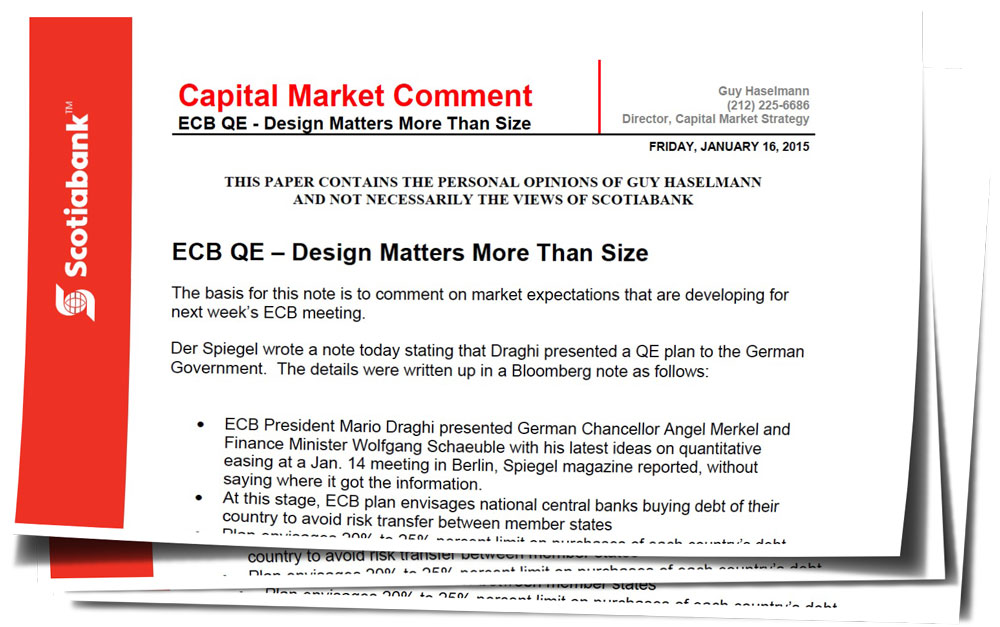ECB QE – Design Matters More Than Size
by Guy Haselmann, Director, Capital Markets Strategy, Scotiabank GBM
THIS PAPER CONTAINS THE PERSONAL OPINIONS OF GUY HASELMANN AND NOT NECESSARILY THE VIEWS OF SCOTIABANK
The basis for this note is to comment on market expectations that are developing for next week’s ECB meeting. Der Spiegel wrote a note today stating that Draghi presented a QE plan to the German Government. The details were written up in a Bloomberg note as follows:
• ECB President Mario Draghi presented German Chancellor Angel Merkel and Finance Minister Wolfgang Schaeuble with his latest ideas on quantitative easing at a Jan. 14 meeting in Berlin, Spiegel magazine reported, without saying where it got the information.
• At this stage, ECB plan envisages national central banks buying debt of their country to avoid risk transfer between member states
• Plan envisages 20% to 25% percent limit on purchases of each country’s debt
• Greece will be excluded from QE because its debt doesn’t fulfill necessary quality criteria
• Dutch Governing Council member Klaas Knot supports putting national central banks in charge of QE implementation. Knot says “if each central bank was only buying debt of its own country, the danger of an unwanted redistribution of financial risk would be lower. Says “we have to avoid that decisions are taken through the back door of the ECB balance sheet that have to continue to be reserved for elected politicians in euro-area countries” By keeping the risk of government-bond purchases at the national level, the ECB would show that it is “exclusively concerned about monetary and not fiscal policy”.
Below is how I interpret, and would subsequently trade, such a plan: Aggressive ECB QE is priced-in and is expected, principally because markets have historically come to realize that Draghi rarely disappoints. The above plan would seemingly qualify as ‘over-delivering’ because the total size may be as high as $1.4- $1.7 trillion, while expectations were recently lowered from $1 trillion to $500 billion.
The $1.4-$1.7 trillion number is roughly obtained by taking the 20% and 25% limits and applying them to the various country debt levels and adding up the totals (see Bloomberg page WCDM).
Nonetheless, there are more important factors than merely looking at the total size of the QE program(s).
There is a low, yet non-zero, probability that Draghi cannot muster the votes to deliver a sizable plan and markets end up with something that disappoints, or is delayed without sufficient detail to appease markets. Should the disappointment be great enough, there is some non-zero probability where Draghi chooses to resign.
The risk/reward of such possibilities - despite the low-probabilities - is good, because of how perfectly priced markets are, and how one-sided are the expectations. More importantly, the greatest probability in my opinion, and the only way I believe Draghi can retain enough votes, is for the Council to reject risk sharing (as suggested in the Der Spiegel article). This means QE will be implemented by the National Central Banks who would be responsible for the purchasing of their own debt. I believe this structure is of critical importance, because unlike other ‘bail-out’ structures, such an action is anti-integration. It would be a step back-ward; a step away from being a union.
Movement towards, or away from, being a union is what has driven the binary aspects of EU sovereign debt spreads for many years. In other words, debt spreads are binary in that they will either converge (union) or diverge (anti-union). Therefore, I believe the structure of ECB QE will ultimately prove much more important than the size of the program.
I believe an excellent trade prior to the ECB meeting (early next week) is to buy US Treasuries in 10’s or 30’s and sell the EU 10 year sector (particularly in Spain, Italy, or even France). For those looking for a cleaner trade, I believe the US/Bund 10 year spread will drop to 80 basis points in the next few months.
Another risk for European markets stems from the Greece vote and discussions around their debt levels. Since they are basically shut out of capital markets and Finland has stated it is adamantly against debt relief, it presents an obstacle, real risks, and the potential for Grexit (the word that every hates).
On a separate but relevant note, the Swiss National Banks has exposed credibility issues of over-burdened central banks. The biggest bubble may not be in stocks or bonds, but rather in the credibility of hyper-active central banks. The SNB basically broke a promise to the market. Markets feel misled. There will be long lasting implications going forward for all central banks. Moreover, the second order spill-over effects from P&L losses and margin calls will be likely be evident in markets for many months.
In general, central bank’s (CBs) are over-promising on what they can likely ultimately deliver. For example, CB’s historically have been able to stop inflation by hiking, but it is unproven that disinflation can be arrested (or inflation created) by cutting rates or printing money; and the long-run negative unintended consequences of attempting extraordinary measures to do so have yet to take hold.
The bottom line is that I believe one of the best trades of the year is shaping up to be the EU periphery divergence trade.
In the meantime (and supporting my bullish US Treasuries view), foreigners (especially Europeans) will prefer buying US Treasuries over European debt until they perceive the upside/downside to the EURO as being balanced. It is unlikely this balance will materialize with an exchange rate, say, above parity. Therefore, a Treasury long against the periphery could turn out to be an outstanding trade.
Download/View/Read Guy Haselmann's entire comment below:
Copyright © Guy Haselmann, Director, Capital Markets Strategy, Scotiabank GBM














